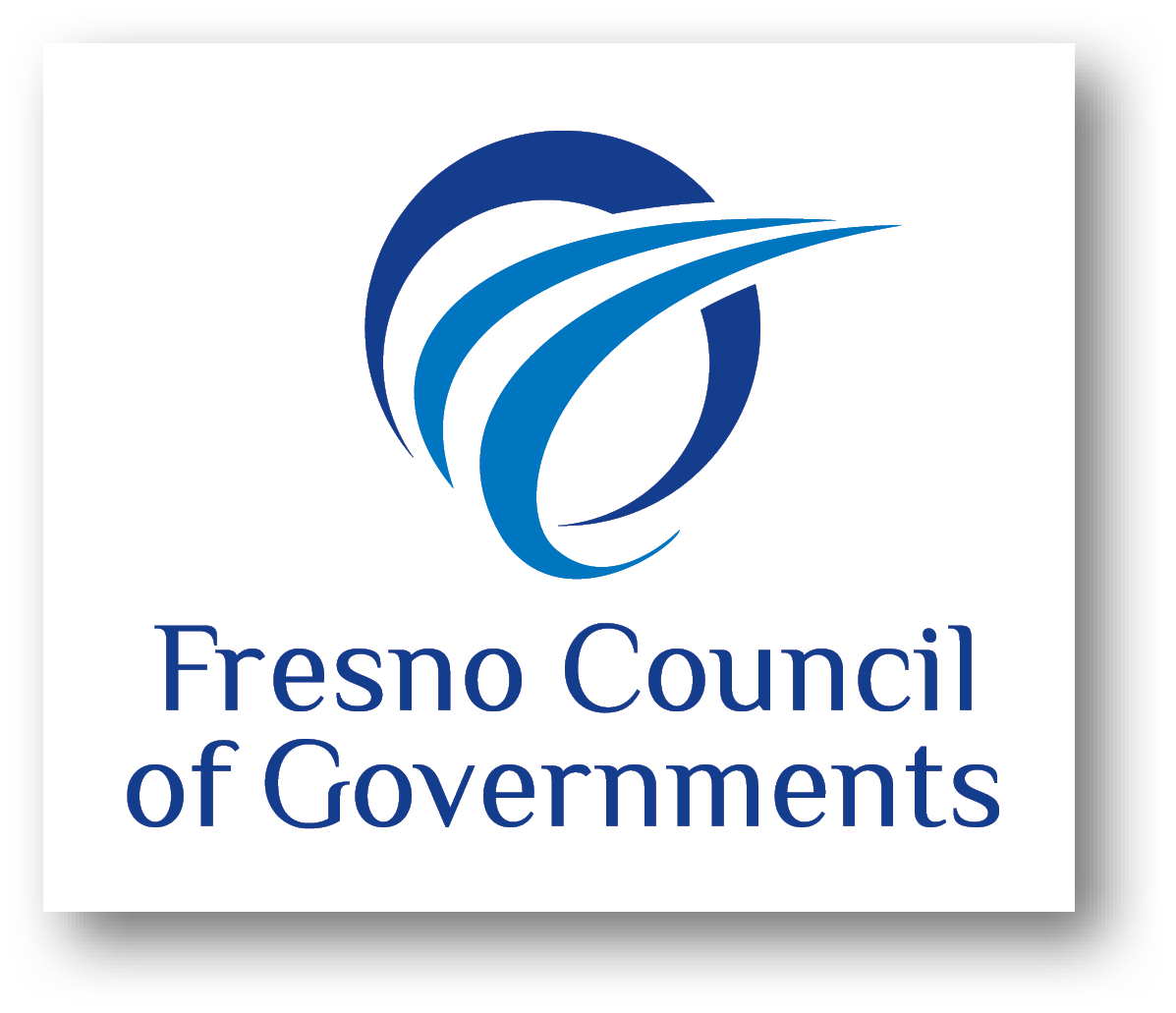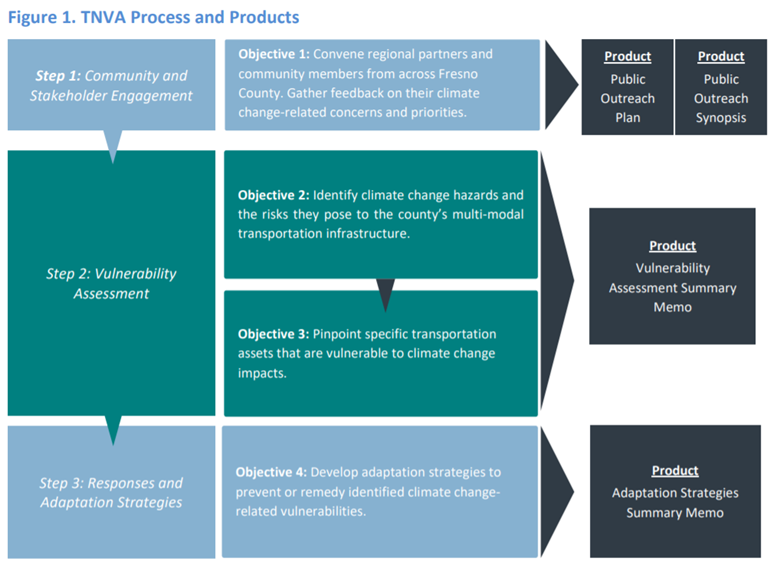Fresno County Regional Transportation Network Vulnerability Assessment
SB1 Adaptation Planning Grant: Final Case Study
Summary
The Fresno Council of Governments (Fresno COG) conducted a Transportation Network Vulnerability Assessment (TNVA) for the Fresno County regional transportation network, which began in the fall of 2018 and concluded in early 2020. The Vulnerability Assessment identifies areas of the region where the multi-modal transportation network is vulnerable to potential impacts of climate change, such as wildfire, extreme heat, and flooding, and identifies strategies to remedy those impacts that have co-benefits to public health, natural ecosystems, social equity, the economy, and greenhouse gas emissions. The Vulnerability Assessment provides information that local agencies may use and integrate within their general plans and inform the next update of the Regional Transportation Plan, as well as identify projects that may be incorporated into future federal, state, and local transportation funding programs.
Lead Agency and Partnerships
Fresno COG was the Lead Agency for this project. As the region’s Metropolitan Planning Organization, Fresno COG built off well-established existing relationships within the region to coordinate an on-going, collaborative approach to regional climate adaptation planning. A Transportation Network Vulnerability Assessment Working Group comprised of government agencies, Caltrans, stakeholders, and community-based organizations helped guide the project through its completion. Fresno COG also has two standing committees made up of community development directors and city managers that meet monthly, as well as the Policy Board, which is made up of the mayors of each city in Fresno County and a Fresno County Board of Supervisor representative. Each of these groups were engaged and provided feedback and direction throughout the process.
Drivers
Factors that motivated this project include: impacts of climate change that the Fresno County region is already experiencing, SB 379 (which requires cities and counties to address climate adaptation and resiliency in the safety elements of their general plans), and the funding opportunity through the SB 1 Caltrans Adaptation Planning Grant Program.
Engagement Process
Community engagement was an important element of the Fresno COG TNVA. It allowed the public and stakeholder agencies to effectively evaluate and comment on the TNVA. It also provided Fresno COG and consultant staff (the TNVA team) with additional information about local concerns related to climate change and what climate hazards already affect day-to-day life. In addition, the public and stakeholders provided helpful feedback about which adaptation strategies they would like to see in their community.
Working with stakeholders and the public was a two-way street, where information and ideas were exchanged between parties, which helped to keep the public informed and guide the direction of the vulnerability assessment.
The following overarching outreach goals were identified when developing the Public Outreach Plan:
- Create public forums and materials that provide clear, concise project information.
- Allow the public and community members to inform the development of the vulnerability assessment.
- Seek opportunities to involve a broad range of community members.
- Engage minority, low-income, and disadvantaged communities.
Multiple strategies were used to generate interest and participation from the community. The TNVA team engaged with the public primarily through pop-up events, community surveys (both online and in person), and a public workshop. The team connected with stakeholders by establishing a Vulnerability Assessment Working Group (VAWG) of local agencies, who guided the development of the TNVA and ensured that the analysis represented and served Fresno County. Stakeholders were also invited to take part in interviews and provide their insight on what climate hazards will have the greatest impact to the Fresno County transportation network and its users. They were also asked about what they would like to see from the TNVA and how the results could benefit their own work.

Climate Impact Area
The climate impact analysis included extreme heat, changes in precipitation, and wildfire. The Vulnerability Assessment evaluated the risk of these impacts on the multimodal transportation network, which includes highways, streets, roads, transit, biking and walking infrastructure. The Vulnerability Assessment highlights vulnerabilities in the transportation network and recommends adaptation strategies to address these vulnerabilities. The findings of this assessment are intended to inform future updates of Fresno COG’s Regional Transportation Plan as well as General Plans of local jurisdictions.
Funding Source
The Vulnerability Assessment was funded through a Caltrans Adaptation Planning Grant for $216,456, from Senate Bill 1, the Road Repair and Accountability Act of 2017. The total project cost was $244,500.
Research and Data
This study looked at the available projections from climate models and other sources to understand how Fresno County’s climate is likely to change in the future. Global Climate Models (GCM) simulate climate over time, drawing on physics, climatology, and historical climate observations. They use assumptions about greenhouse gas emissions and other factors to forecast future climate conditions. For this study, the COG used projections from the 10 models suggested by state agencies as being most representative of climate change across the state from California’s 4th Climate Change Assessment (2018) and state guidance documents.
Challenges
Engaging local residents and agencies in the process was essential to ensuring the comprehensiveness of the Vulnerability Assessment, and that the projects and strategies identified by the Vulnerability Assessment are carried out. The COG’s standard workshop approach wasn’t as successful as with other projects. So instead, outreach was conducted at existing community events to talk to residents.
Outcomes
The Final Vulnerability Assessment Summary Report (Summary Report) summarizes the outputs of Fresno COG’s TNVA, which had three main steps: 1) engage with the community and stakeholders, 2) conduct a vulnerability assessment of the transportation network’s exposure to different climate hazards, 3) and develop responses to potential impacts and adaptation strategies that build the resiliency of the network.
The following products were developed to summarize each step of the TNVA:
- Public Outreach Plan
- Public Outreach Synopsis
- Vulnerability Assessment Summary Memorandum
- Adaptation Strategies Summary Memorandum
The Summary Report provides a synopsis of each document listed above and is intended to act as an Executive Summary for the entire TNVA, including a snapshot of the entire process. Figure 1 provides an overview of the TNVA process, including its three main steps, the core TNVA objectives met through those steps, and final TNVA products. See the Appendix to review the complete TNVA products and results.
Additional Resources
- Fresno County Transportation Network Vulnerability Assessment: Final Summary Report: https://www.fresnocog.org/wp-content/uploads/2017/06/FCOG-DRAFT-Final-Report_200331_wAppendices.pdf
-
Caltrans District 6 Vulnerability Assessment: http://www.dot.ca.gov/transplanning/ocp/vulnerability-assessment.html
Replicability
It is the hope that the vulnerability assessment could be used as one example to be replicated by other regional transportation planning agencies, cities, and counties.
Further Information
For additional information, please contact Meg Prince, Associate Regional Planner, at mprince@fresnocog.org or 559-233-4148.

